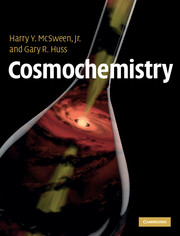Book contents
- Frontmatter
- Contents
- Preface
- 1 Introduction to cosmochemistry
- 2 Nuclides and elements: the building blocks of matter
- 3 Origin of the elements
- 4 Solar system and cosmic abundances: elements and isotopes
- 5 Presolar grains: a record of stellar nucleosynthesis and processes in interstellar space
- 6 Meteorites: a record of nebular and planetary processes
- 7 Cosmochemical and geochemical fractionations
- 8 Radioisotopes as chronometers
- 9 Chronology of the solar system from radioactive isotopes
- 10 The most volatile elements and compounds: organic matter, noble gases, and ices
- 11 Chemistry of anhydrous planetesimals
- 12 Chemistry of comets and other ice-bearing planetesimals
- 13 Geochemical exploration of planets: Moon and Mars as case studies
- 14 Cosmochemical models for the formation of the solar system
- Appendix: Some analytical techniques commonly used in cosmochemistry
- Index
- References
6 - Meteorites: a record of nebular and planetary processes
Published online by Cambridge University Press: 05 June 2012
- Frontmatter
- Contents
- Preface
- 1 Introduction to cosmochemistry
- 2 Nuclides and elements: the building blocks of matter
- 3 Origin of the elements
- 4 Solar system and cosmic abundances: elements and isotopes
- 5 Presolar grains: a record of stellar nucleosynthesis and processes in interstellar space
- 6 Meteorites: a record of nebular and planetary processes
- 7 Cosmochemical and geochemical fractionations
- 8 Radioisotopes as chronometers
- 9 Chronology of the solar system from radioactive isotopes
- 10 The most volatile elements and compounds: organic matter, noble gases, and ices
- 11 Chemistry of anhydrous planetesimals
- 12 Chemistry of comets and other ice-bearing planetesimals
- 13 Geochemical exploration of planets: Moon and Mars as case studies
- 14 Cosmochemical models for the formation of the solar system
- Appendix: Some analytical techniques commonly used in cosmochemistry
- Index
- References
Summary
Overview
Most meteorites (~86%) are chondrites, which are primitive rocks that have elemental compositions similar to that of the Sun. They are named for the millimeter-sized droplets of quenched silicate melt, called chondrules, that are particularly abundant in these meteorites. Chondrites come from the asteroid belt. They are physical mixtures of accreted components (chondrules, refractory inclusions, metal and sulfide, dust) whose characteristics and mineralogy we will describe. The classification of chondrites utilizes a combination of primary features (bulk chemical composition, oxygen isotopes) and secondary features (thermal metamorphism or aqueous alteration). About 14% of meteorites arriving on Earth consist of differentiated materials. Their compositions have been affected by melting and crystallization, and they include various kinds of achondritic meteorites, irons, and stony irons from the asteroid belt, along with lunar samples and Martian meteorites. Achondrites, so-named because they do not contain chondrules, are divided into two types. Primitive achondrites are the solid residues left behind after extraction of partial melts from chondritic material. Magmatic achondrites crystallized from the extracted melts or from completely melted and differentiated chondritic material. Irons and stony irons formed by separation of molten metal/sulfide from silicates. Lunar rocks include cumulates from the ancient highlands and mare basalts that flooded huge craters. Martian meteorites include basalts and cumulates formed from basaltic magmas.
Primitive versus differentiated
Cosmochemistry is the study of the chemical compositions of various solar system materials. Chondrites are the most abundant primitive samples.
- Type
- Chapter
- Information
- Cosmochemistry , pp. 157 - 191Publisher: Cambridge University PressPrint publication year: 2010



